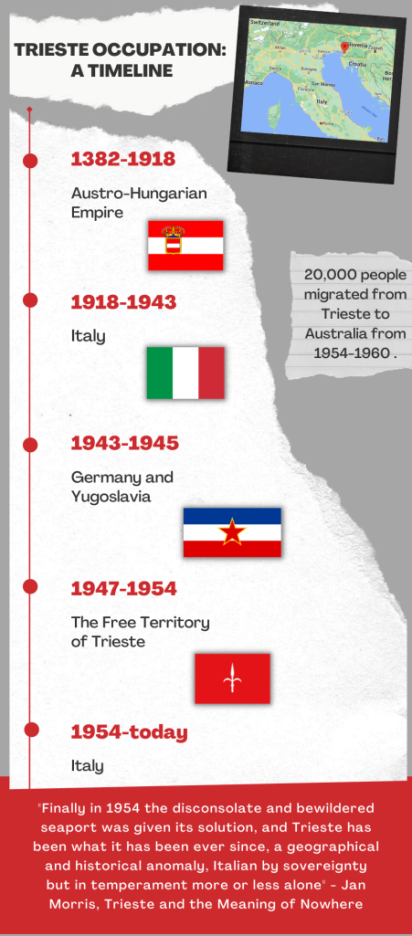For older Australian migrants, Putin’s war brings up painful memories
Every night, it felt like on the hour the air raid sirens would start and a young Sonia Franz would drag herself out of bed and down to the bunker.
Spiralling back up the staircase when the sirens ceased required her to tiptoe over broken glass from shattered windows and crawl back into bed, before doing it all over again.
Mrs Franz grew up in an orphanage in Trieste – a port city in northern Italy – during World War II.
When she was five, her mother died from an unknown illness and her father was serving in the war leaving her in one of the many orphanages in the city.
After the war she moved to Melbourne, married and had two children with only a scattering of photos and stories to remember her past life.
In 2022, when 89-year-old Mrs Franz sees footage from war-torn Ukraine plastered on her TV it serves as a chilling reminder that nothing has changed.
Trieste was part of the Austro-Hungarian Empire until 1918, where it flourished as a duty and tax-free port.
After WWI, at the fall of the Empire, the city was conceded to Italy but it was during WWII that Trieste suffered the most.
Guy Zamarini, member of the Trieste Social Club in Essendon, remembers his childhood in the war-torn city.
In 1943, he explains, Trieste was seized by the Germans.
“The Nazis set up a concentration camp in an old rice factory where it is estimated 3-5,000 people were killed,” Mr Zamarini says.
In 1945 a revolt against the Nazis saw Yugoslav Partisans and the Allied Forces race to capture the city.
“Trieste was wanted territory particularly by Josip Broz Tito, the former president of the Socialist Federal Republic of Yugoslavia,” he says.
“Yugoslavia was a very peasant-based country and by taking over Trieste, Tito would have access to the port.”
 A division from New Zealand – part of the Allied Forces – raced across the north of Italy while the communist Yugoslav Partisans came from the east.
A division from New Zealand – part of the Allied Forces – raced across the north of Italy while the communist Yugoslav Partisans came from the east.
The Partisans got there first.
“That was when the most tragic chapter in Trieste’s history started,” Mr Zamarini says.
During the invasion Yugoslav Partisans committed the Foibe massacres, killing local ethnic Italians.
Foibe refers to naturally-occurring sinkholes around Trieste and the surrounding areas of Gorizia and the Istrian Peninsula.
“They’d tie 10 or 12 people together and lead them to the foibe,” he says.
“They’d stand them at the top of the foiba and shoot the first one and as he went over he’d pull the next one down, and the rest would fall…they’d only use one bullet to kill 12 people.”
Mr Zamarini describes how people survived when they landed in the bottom of the foibe.
“A few managed to crawl back out but most of them had broken limbs,” he says.
“Farmers could often hear the screams for days after with people still alive at the bottom of these foibe.”
It is unknown how many people were killed in the massacres but estimates suggest the number is around 15,000.
Yugoslav forces withdrew from Trieste on 12 June 1945, relinquishing the city to joint British-US military administration.
In 1947 a peace treaty was signed that created the Free Territory of Trieste, guaranteed by the United Nations Security Council, before Trieste was officially annexed to Italy in 1954.
If you were to visit the city today, you’d see a collision of cultures that both embrace and resent Italian nationhood.
In a busy street, a shop window still proclaims, “welcome to the free territory of Trieste” and “USA & UK come back”.
Trieste’s unique ethnic makeup and colourful history sets it apart from the nations it borders.
Mr Zamarini refers to Trieste as one of the most “complex” cities in Italy and Mrs Franz emphatically proclaims she is not Italian, but instead Triestin.
Identity politics continues to be a point of debate in Trieste, similar to how Ukraine and Russia’s competing identities have been noted in a study by the University of Oxford.
This research explains that Putin’s actions in 2022 are likely “motivated by a desire to re-establish the Soviet Union”, but Ukrainians have largely rejected a Soviet identity.
In 2014, 21 percent of Ukrainians identified with the Soviet Union, compared to 58 percent who identified with Ukraine.
Another identity surfaced at the 2020 EU-Ukraine Summit, when Ukrainian President Volodymyr Zelenskyy said that Ukrainians are “quintessentially European”.
Old European stereotypes argue that Western Europe is civilised while the East, traditionally including Ukraine, make up the “barbaric hinterlands”.
But Ukraine’s European identity has been supported by European Union Commission President Ursula von der Leyen, who told Euronews that Ukraine is “one of us and we want them in the European Union”.
Like the residents of Trieste, Ukrainians’ identity is made complex by its borders and history.
But for survivors of war watching images of Ukrainians making Molotov cocktails and bearing arms in support of their nation, the Ukrainian spirit appears steadfast.
Franz recalls pacing war-torn streets in Trieste as a young girl, numb to the sight of dead bodies rotting on the side of the path.
The ugliness of war however could not kill the city’s unwavering Triestin pride.
She remembers a song they used to sing.
“It’s called, ‘Viva l’A e Po’ Bon’ and the song says: live your life as it comes, that’s the motto of Trieste,” she says.



